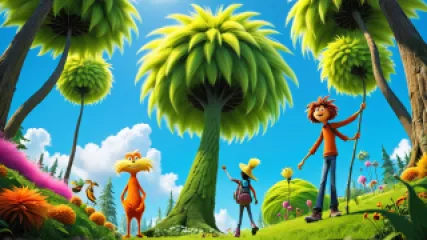Unlocking Eco-Anxiety Relief: Lessons from 'The Lorax' on Sustainable Living
Unlocking Eco-Anxiety Relief: Lessons from 'The Lorax' on Sustainable Living
Embracing Eco-Consciousness through Literature
In today's world, where environmental concerns loom large, it's crucial that we find ways to address the growing issue of eco-anxiety – the emotional distress caused by the perceived threats to the planet's wellbeing. As we grapple with the challenges of sustainable living, we can turn to the wisdom of literary works to provide guidance and inspiration. In this article, we'll explore how the beloved children's book "The Lorax" by Dr. Seuss can offer valuable insights into cultivating an environmentally conscious mindset and finding psychological sustainability in the face of eco-anxiety.
Recognizing the Roots of Eco-Anxiety
Eco-anxiety, a term that has gained increasing prominence in recent years, can be described as a deep sense of worry, fear, and even despair about the state of the environment and the future of our planet. This condition can manifest in a range of emotional and physical symptoms, from feelings of helplessness and guilt to insomnia and panic attacks.
At its core, eco-anxiety is a rational response to the very real threats posed by climate change, environmental degradation, and the unsustainable practices that have become deeply embedded in our societal and economic structures. As we witness the devastating effects of human activities on the natural world, it's understandable that many of us feel overwhelmed, anxious, and uncertain about the future.
Lessons from 'The Lorax'
In the whimsical and thought-provoking world of "The Lorax," Dr. Seuss presents a cautionary tale that resonates profoundly with the environmental challenges we face today. Through the lens of this beloved children's book, we can uncover valuable lessons that can help us navigate the complexities of eco-anxiety and foster a more sustainable and eco-psychological approach to living.
The Importance of Mindfulness and Observation
At the heart of "The Lorax" is the character's keen observation of the natural world and his unwavering commitment to protecting it. The Lorax, with his sharp eyes and attentive nature, serves as a powerful reminder of the importance of mindfulness and observation in our own lives.
In the face of eco-anxiety, cultivating a mindful and observant approach can be a transformative tool. By taking the time to truly see the world around us, we can develop a deeper understanding of the interconnected web of life and the subtle changes that are unfolding. This heightened awareness can help us identify the root causes of environmental degradation and empower us to take meaningful action.
As the Lorax so eloquently states, "I am the Lorax. I speak for the trees. I speak for the trees, for the trees have no tongues." By adopting a similar posture of advocacy and vigilance, we can become the guardians of our natural world, speaking up for the voiceless and championing the preservation of our planet's precious resources.
The Power of Individual Action
One of the most powerful lessons from "The Lorax" is the recognition that individual actions, no matter how small, can have a profound impact on the trajectory of environmental change. The book's protagonist, the Once-ler, serves as a cautionary tale of how the pursuit of personal gain and the disregard for the wider ecological consequences can lead to devastating consequences.
In the face of the overwhelming challenges posed by climate change and environmental degradation, it's easy to feel powerless and to believe that our individual efforts are insignificant. However, the Lorax's unwavering commitment to speaking up and taking action, even in the face of seemingly insurmountable odds, reminds us that every person has the ability to make a difference.
By adopting eco-conscious habits, such as reducing our carbon footprint, supporting sustainable businesses, and engaging in local environmental initiatives, we can collectively contribute to the larger movement towards a more sustainable and eco-psychological future. The Lorax's message encourages us to believe in the power of individual agency and to take ownership of our role in shaping the world we want to see.
The Necessity of Collaboration and Community
While individual action is crucial, the Lorax also underscores the importance of collaboration and community in addressing environmental challenges. In the book, the Lorax's efforts to save the Truffula trees are ultimately thwarted by the Once-ler's relentless pursuit of profit, a cautionary tale of the dangers of prioritizing individual gain over collective wellbeing.
In the realm of eco-anxiety, the lesson of collaboration and community is equally vital. Addressing the complex and multifaceted issues of environmental degradation and climate change requires a concerted effort from individuals, communities, and institutions alike. By fostering a sense of collective responsibility and working together towards common goals, we can amplify our impact and create lasting, systemic change.
This could involve joining local environmental organizations, participating in community-based initiatives, or supporting policies and legislation that prioritize environmentally conscious practices. By embracing the spirit of the Lorax and recognizing the power of togetherness, we can cultivate a more resilient and psychologically sustainable approach to safeguarding our planet.
Nurturing Eco-Psychological Resilience
As we delve into the lessons of "The Lorax," it's essential to recognize that addressing eco-anxiety is not solely about external actions and environmental preservation. It also requires a deep exploration of our own psychological sustainability and the cultivation of inner resilience.
Fostering a Connection with Nature
One of the most powerful antidotes to eco-anxiety is the cultivation of a deep, meaningful connection with the natural world. The Lorax's unwavering love and reverence for the Truffula trees serve as a poignant reminder of the intrinsic value of nature and the importance of fostering a sense of kinship with our environment.
By actively engaging with the natural world through activities like hiking, gardening, or simply spending time outdoors, we can develop a heightened sense of appreciation and stewardship. This connection can help alleviate feelings of helplessness and provide a sense of grounding and purpose in the face of environmental challenges.
Furthermore, research has shown that exposure to nature can have profound psychological benefits, including reduced stress, improved mood, and enhanced cognitive function. By nurturing this connection, we can cultivate a more resilient and eco-psychological approach to navigating the complexities of eco-anxiety.
Embracing Hopeful Narratives
Another crucial aspect of addressing eco-anxiety is the cultivation of hopeful narratives. While "The Lorax" presents a cautionary tale of environmental destruction, the book also offers a glimmer of hope through the final pages, where the reader is left with the promise of a new beginning and the potential for regeneration.
In a world that can often feel overwhelmed by the magnitude of environmental crises, it's essential to embrace narratives that inspire hope and empower us to take positive action. By focusing on the stories of individuals and communities who are actively working towards sustainable solutions, we can cultivate a sense of optimism and inspiration that fuels our own eco-psychological journey.
This could involve seeking out and sharing stories of successful eco-psychological interventions, innovative sustainable practices, or grassroots initiatives that are making a tangible difference. By surrounding ourselves with these hopeful narratives, we can counterbalance the often-pervasive messages of doom and gloom, and instead nurture a sense of psychological sustainability and resilience.
Developing Eco-Centric Coping Strategies
Ultimately, addressing eco-anxiety requires the development of eco-centric coping strategies that prioritize both individual and collective wellbeing. Drawing inspiration from the Lorax's unwavering commitment to his cause, we can cultivate a range of practices and techniques that help us navigate the emotional and psychological challenges of environmental concerns.
This could involve incorporating mindfulness and meditation practices to cultivate a sense of presence and grounding, engaging in creative or artistic pursuits that allow for self-expression and emotional release, or seeking out the support of like-minded communities and mental health professionals who specialize in eco-psychological interventions.
By embracing a holistic approach that integrates environmentally conscious actions with psychologically sustainable practices, we can foster a greater sense of agency, empowerment, and resilience in the face of eco-anxiety.
Conclusion: Unlocking the Transformative Power of 'The Lorax'
In the enchanting world of "The Lorax," Dr. Seuss has gifted us with a timeless tale that resonates profoundly with the environmental challenges of our time. By delving into the book's powerful lessons, we can unlock valuable insights that can guide us towards a more sustainable and eco-psychological approach to living.
Through the Lorax's unwavering dedication, we are reminded of the importance of mindfulness, the power of individual action, and the necessity of collaboration and community in addressing the pressing issues of environmental degradation and eco-anxiety. By nurturing our connection with nature, embracing hopeful narratives, and developing eco-centric coping strategies, we can cultivate a sense of psychological sustainability that empowers us to be the agents of positive change our planet so desperately needs.
As we navigate the complexities of the 21st century, let us take inspiration from the timeless lessons of "The Lorax" and embark on a journey of eco-psychological transformation. By embracing the book's profound wisdom, we can unlock the path towards a more environmentally conscious and psychologically sustainable future for ourselves and generations to come.






